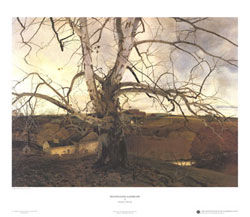
Pennsylvania Landscape
The Kuerner Farm
The Kuerner Farm was located just over the hill from where Andrew Wyeth was born. Everyday of his life spent in Chadds Ford, Wyeth would look upon the old farm and feel a sense of intrigue. The owner of the farm, Karl Kuerner, had been a soldier in the German army and had moved to America after the war. Upon arriving in Chadds Ford, Kuerner was first a hired farm hand, but years later he would own the property. For Wyeth, the personal history of Karl Kuerner had the effect of making the farm seem abstract and almost military and these impressions are clearly felt in some of his paintings depicting the farm. Some of the works that are associated with the Kuerner farm include Spring Fed (1967), Evening at Kuerners (1970), Anna Kuerner (1971) and the double portrait of The Kuerners (1971).
A Landscape Mired in Tragedy
In October 1945, tragedy struck the Wyeth family when the father was killed in a railway crossing accident. Although Andrew Wyeth was devastated, he claimed that the accident left him with a new resolve to become a great artist. In the years following the accident, Wyeth’s work shows an increased sense of emotion and poignancy. In the winter of 1946, Wyeth began work on a tempera painting that showed the form of a young boy running down a hill with the sun casting an accompanying shadow. In an interview following the unveiling of the piece, Wyeth stated that the hill was a portrait of his father, as it was at the crossing just on the other side of the hill that his father had been killed.